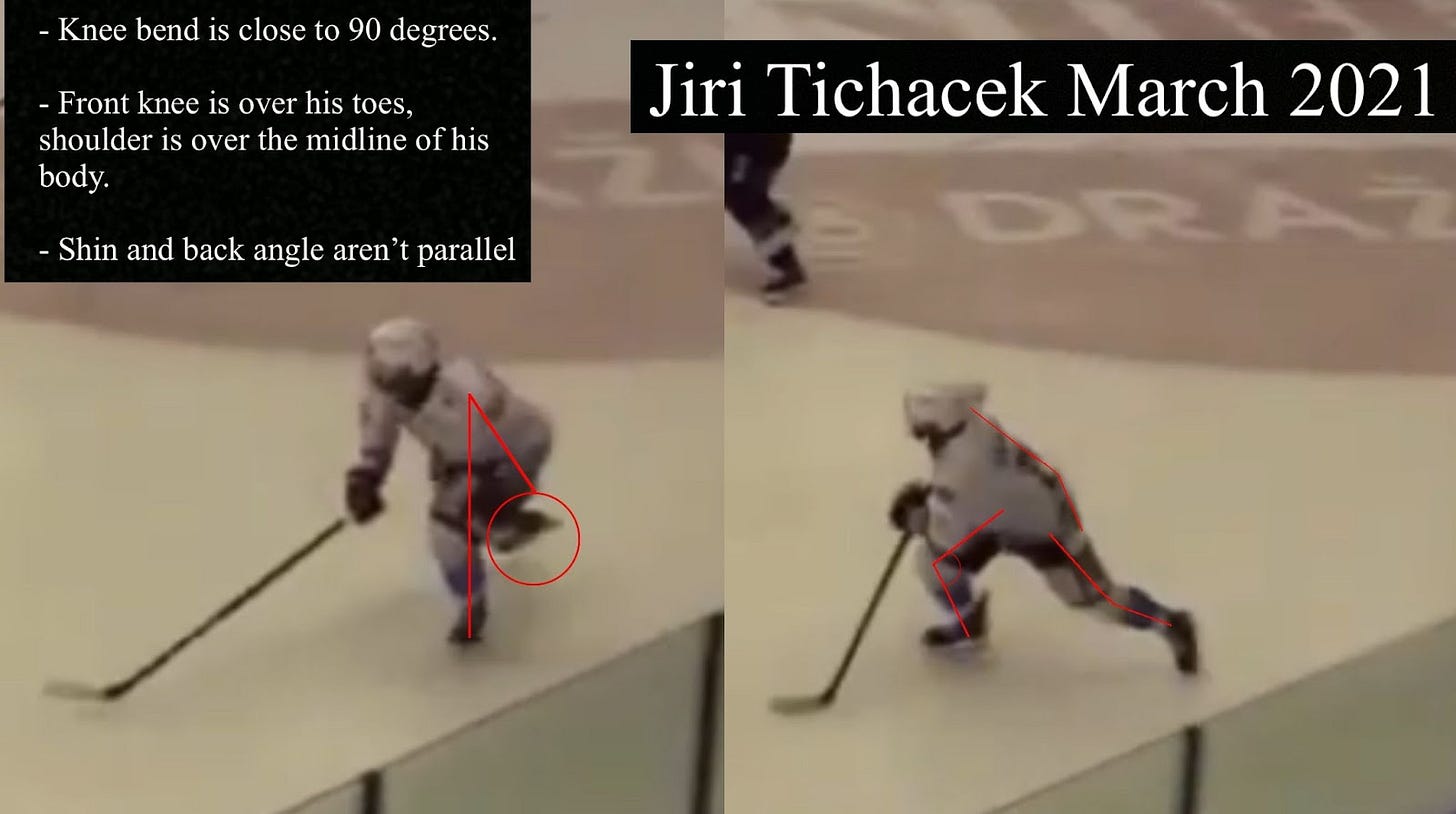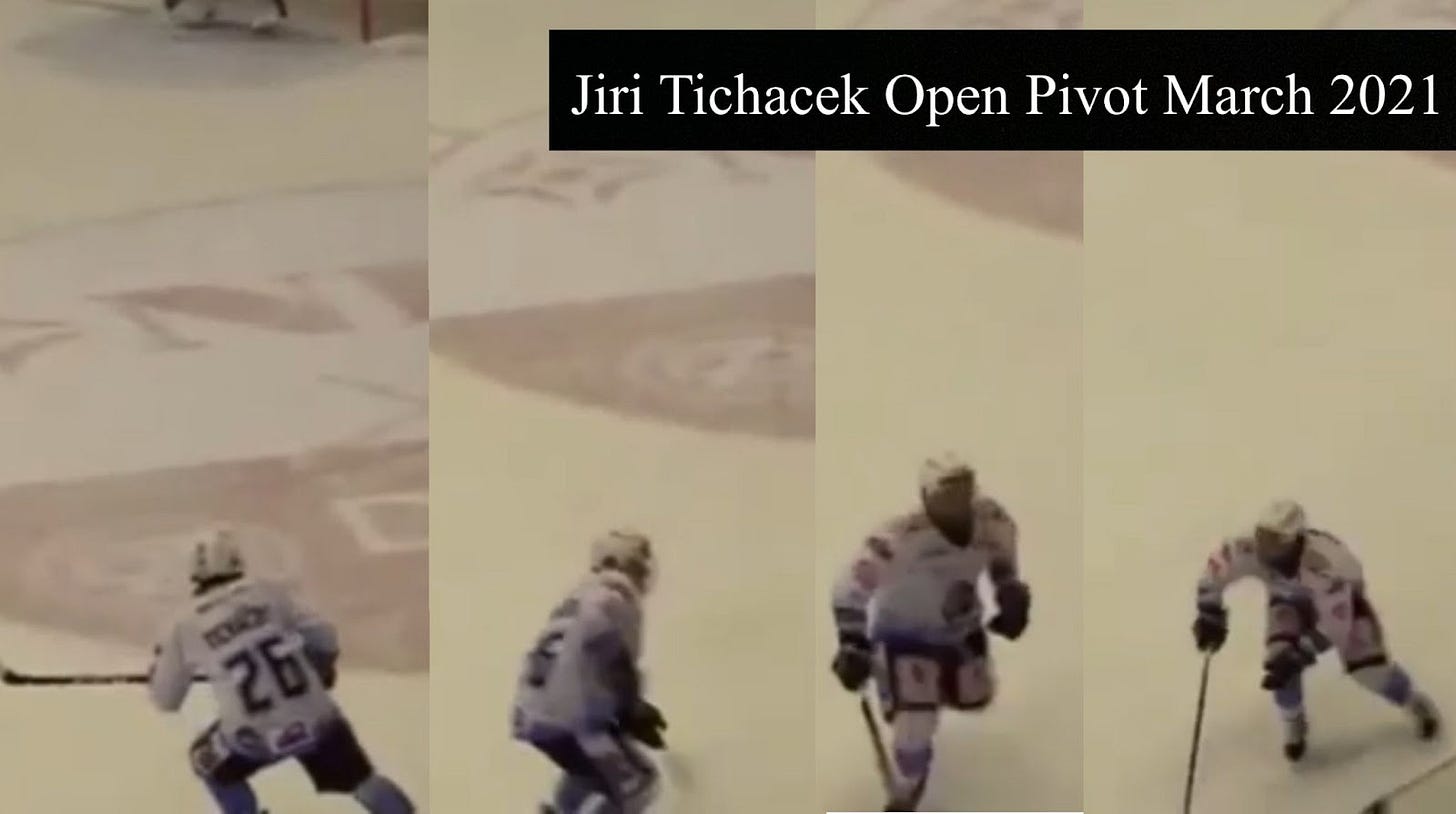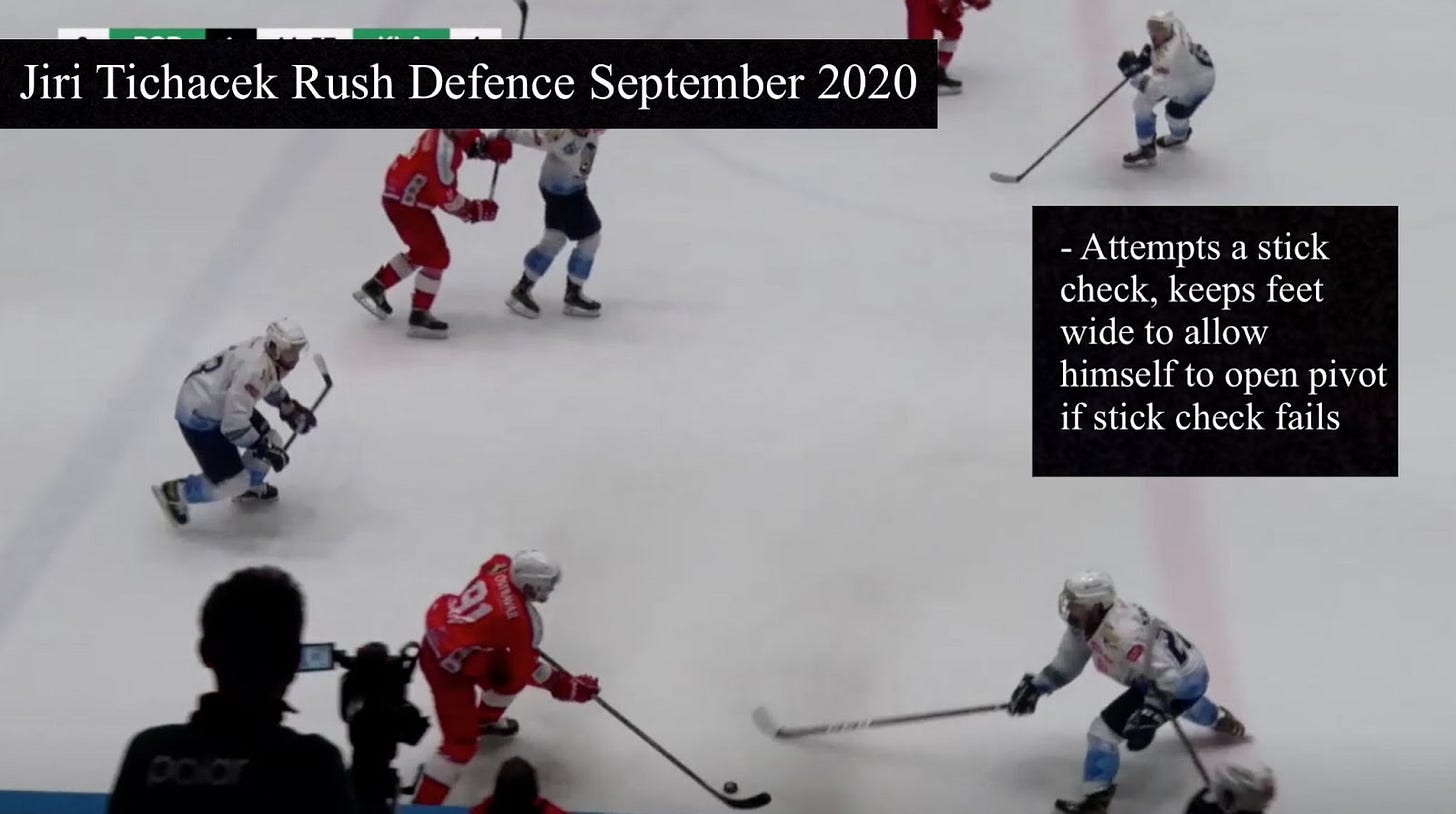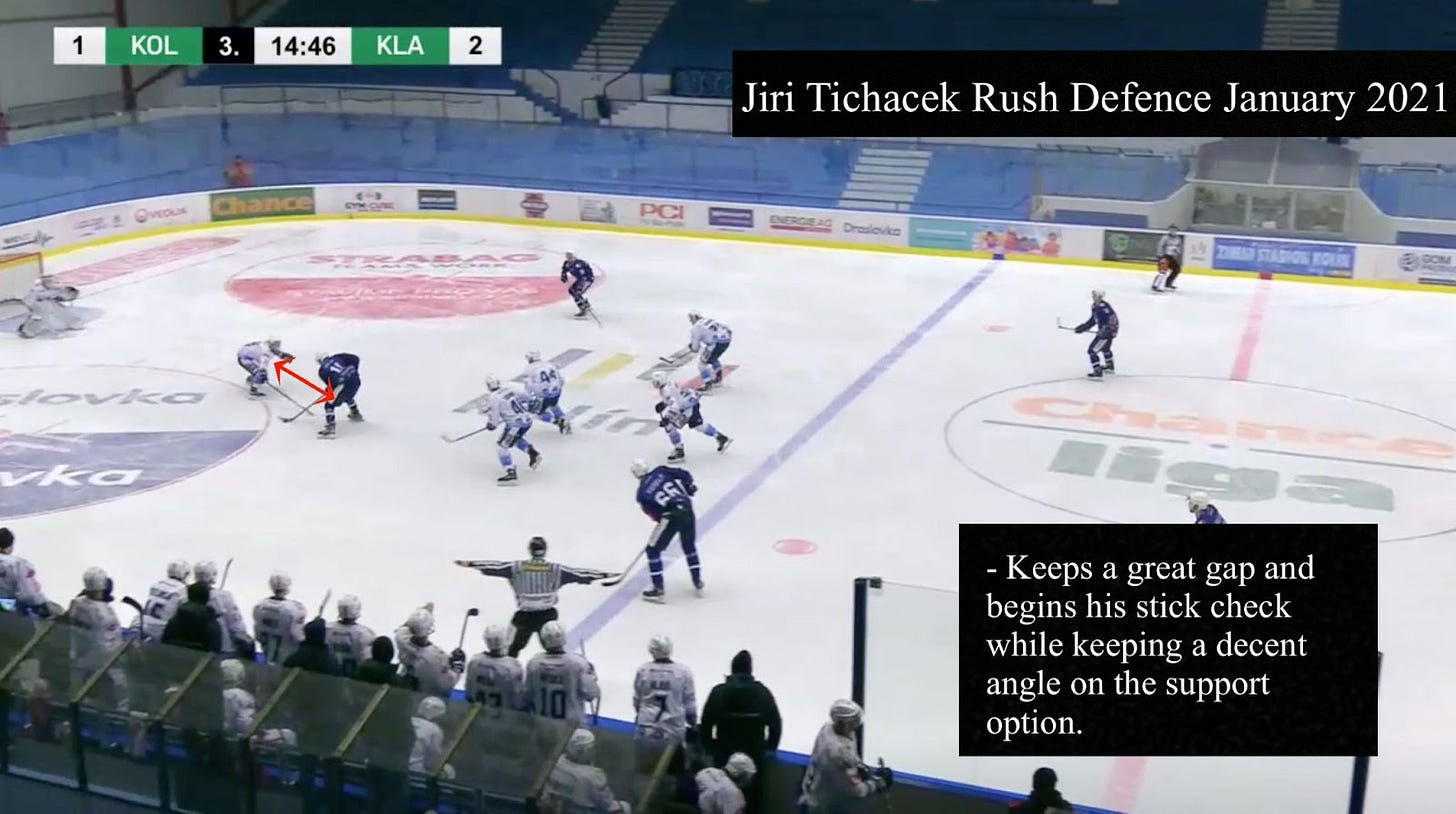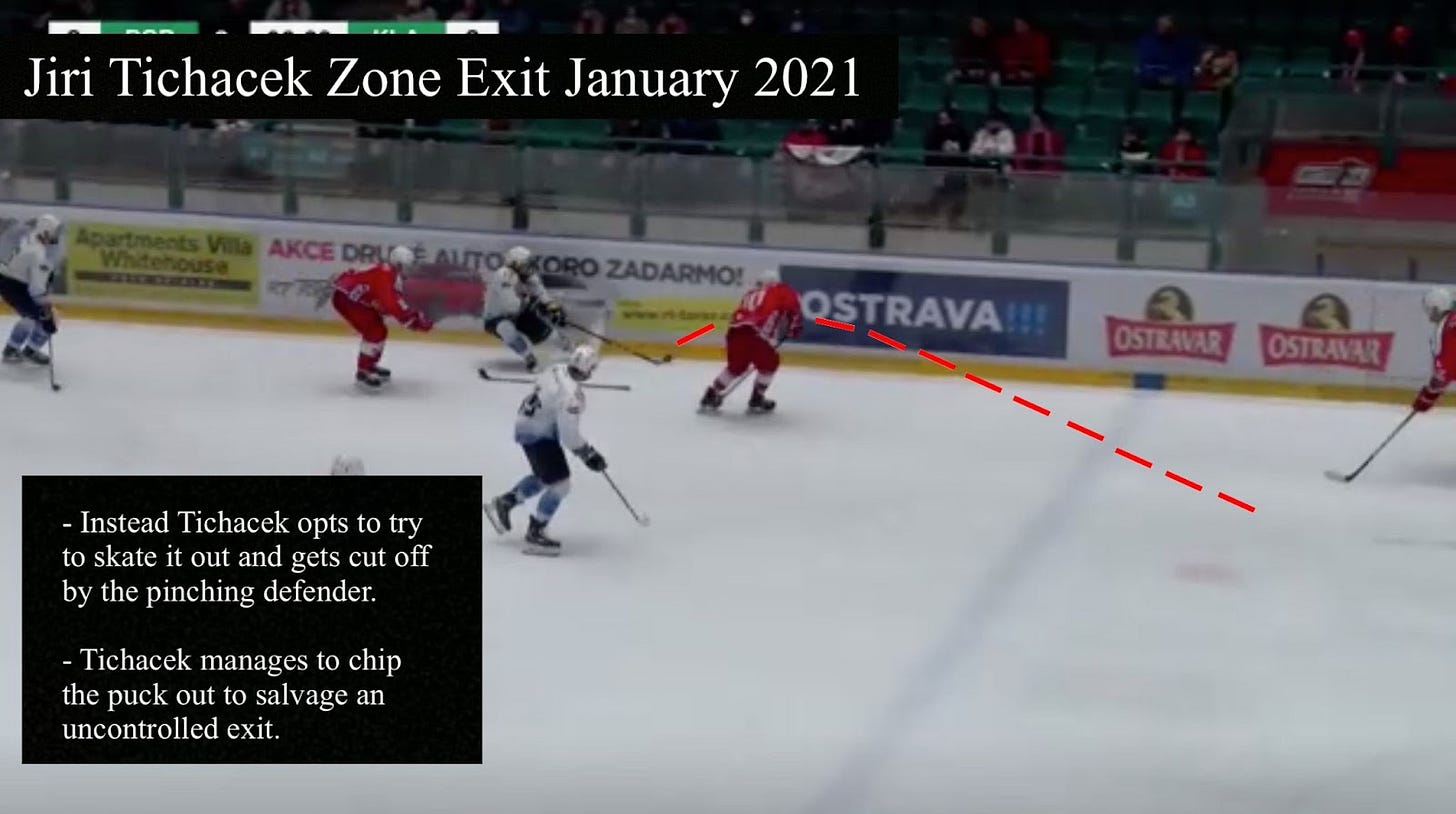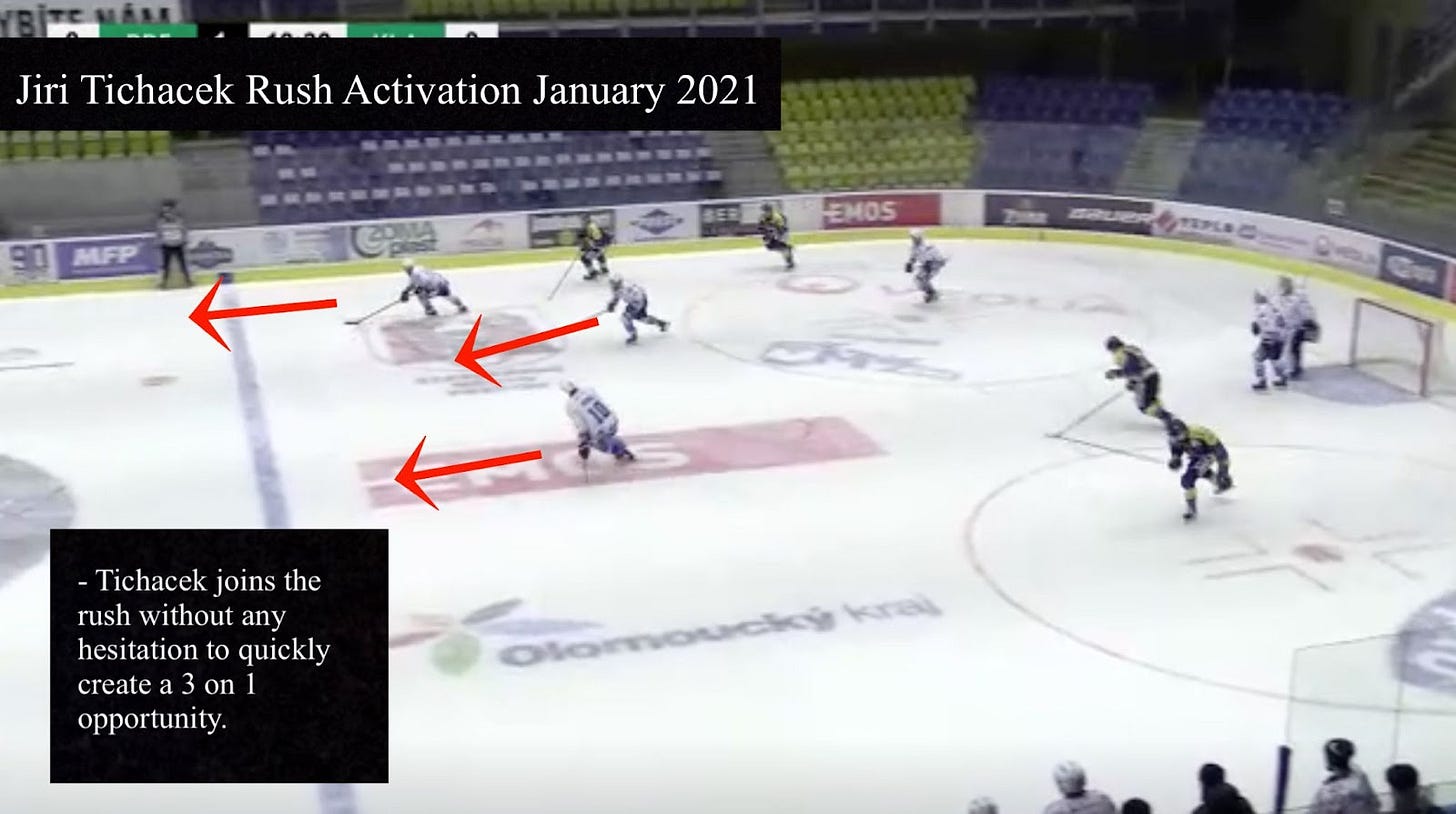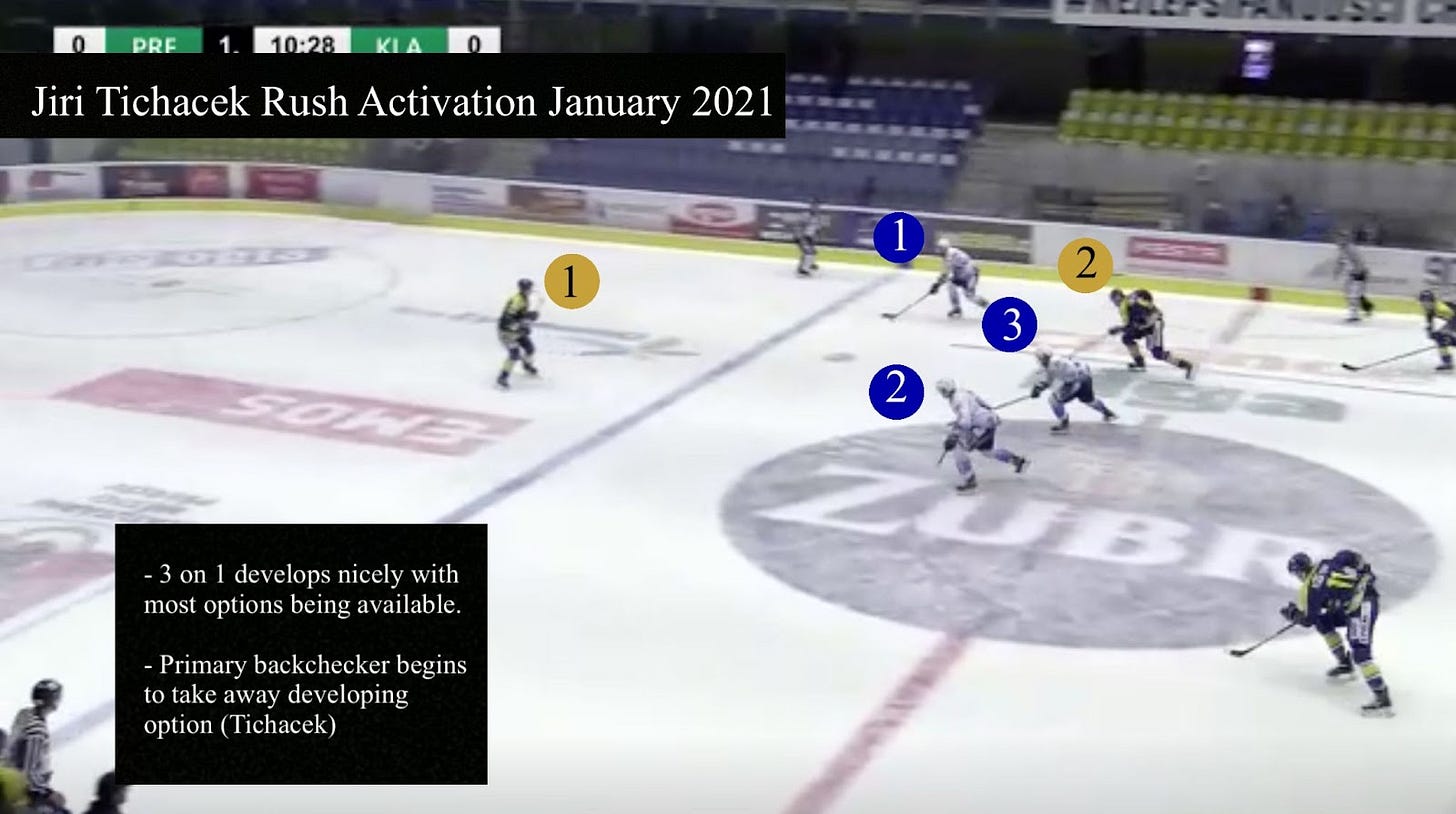| LD | Rytiri Kladno (Chance Liga) | 5-8 | 169lbs
Skating:
- Straight Line Skating:
In a straight line, Jiri Tichacek can get caught a stride or two behind a forechecker. He needs development both in general posture and efficient force generation. He does stay low to hold balance and produce stride power well by bending his knee close to 90 degrees and keeping his knees over the toe of his skates, and his shoulders over the midline of his body but the positives stop there. His shin and back angle aren’t parallel meaning he loads from his hip and back instead of loading through his ankles. This interferes with his weight transfer up the kinetic chain hence the lack of full hip activation. It doesn’t appear to be a lack of ankle flexion that causes this either, as Tichacek shows great lateral skating ability and the ability to protect the puck well while rotating. Something that someone who has poor ankle dorsiflexion would have difficulty doing. Rather, I believe that Tichacek’s posture issues have more to do with learned experience rather than any deep rooted issue that might be more difficult to correct. Furthermore, Tichacek does well to turn his back foot and dig his edges into the ice to create a good amount of force in his push off but he doesn’t push his front knee far enough forwards to keep that momentum going into the following strides despite coming close to reaching full leg extension with the back leg. Much like his posture, Tihacek’s stride recovery movement should be one of the first things worked on if he is drafted.
Another thing to point out about Tichacek’s straight line skating is that he swings his arms side-to-side instead of forwards to backwards while he skates. Using a larger range of motion in the arms as well as keeping the arms moving in the same direction will result in a more efficient transfer of energy and use more of the generated power with each stride.
Jiri Tichacek managed to reach a top speed of 33.41km/hr in the 3 Chance Liga games I’ve tracked of his this season. This is below average for a defender of his age and can be explained by poor straight line skating posture and stride efficiency.
-Lateral And Backwards Skating:
There are few skaters outside the top 15 of this draft that are as mobile and as projectibaly positive lateral skaters as Jiri Tichacek. It is the one of the most noticeable qualities Tichacek holds and is the key to his diverse skill toolbox. Tichacek leverages his confidence on his edges by using weaving crossovers to artificially increase his lateral mobility. By doing this it not only adds unpredictability to his movements also allows for quicker acceleration and deceleration, a pillar for creating space for yourself. With that being said, moving in a straight line, Tichacek should look to use linear crossovers more often to leverage his explosiveness and lower body strength. Tichacek averaged a crossover once every 6.5 strides in the 3 chance Liga games I tracked of his. Tichacek’s edge control is exceptional. In all aspects of his skating this is visible everywhere in his mechanical skating base. His striding, crossovers, stops and starts, and glide turns are all improved because of how well and frequently he uses his edges. That comes a lot from his great ankle dorsiflexion, allowing both his inside and outside edges to get closer to the ice, causing a tighter, more compact turning radius. His mobility allows Tichacek to support partners on defensive rushes and move laterally fluidly to open and close available gaps, and escape pressure to at least put himself in positions to see the ice well and make the correct reads once the puck is won back.
Tichacek has shown the ability but more importantly, the tendency to open pivot under pressure and at the appropriate times. Like most of his non straight line skating, Tichaeck’s technique is great, he opens his hips to create a faster pivot that allows him to keep an angular advantage when turning. Many defenders his age revert to the more comfortable crossover pivot on plays such as puck retrievals but Tichaeck prefers the more optimal open pivot.
Skills:
- Rush Defence
Facing transition offense, Tichacek was excellent against men this year, neutralizing opportunities and closing out available space very effectively. You might think a smaller defender like Tichacek would get beat out wide often because of his short reach, but Tichacek showed his class in gap management through his outstanding lateral agility, and smart spatial awareness that looks both effective at the Czech 2nd division level and translatable to higher levels that play at a higher pace. Tichacek plays a textbook high energy rush defence game, staying roughly two stick lengths away, keeping a tight enough gap to maintain pressure but also enough of a front gap to not run the risk of being beaten by a quick burst of speed while constantly moving his feet and adjusting to the directional changes the oncoming attacker shows. He can face and disrupt multiple angles of attack which is something that even many pro defenders have difficulty with, when the rush attack is not linear. How defenders defend entries and the in-zone entry sequence is vital to predicting future goal suppression. Being such a great lateral skater affords Tichacek the ability to defend entries by gapping up with the intent to break up the entry instead of having to maintain inside position to force a low quality shot. He is usually very consistent at keeping a tight, well angled gap as well, with only a few examples of poor gap management coming out in my viewings.
Apart from his mobility, the standout skill that makes Tichacek so effective at stopping rush opportunities is identifying the developing play. By using awareness tools Tichacek seems to identify the speed in which the oncoming attacker is coming at him, whether or not they are on their strong or off-wing, the support they have, what their passing options are and what space is available for them to skate into very well. By assessing these elements, he is more equipped with the knowledge of the different threats that attackers are capable of and can put himself in a better position to win possession back. For example, Tichacek coverage of the dot line or “half space” is usually very good, preventing players from crossing into different assignment zones as to confuse the defensive coverage.
With that being said, Tichacek does lack the physical tools to be able to separate the opponent from the puck if stick checking ability fails him on a defensive rush. He can get caught getting squeezed out along the boards after forcing his man to the corner, which eliminates his effectiveness at preventing scoring opportunities. That is something that can be mitigated by putting in time in the weight room but can never fully be fixed due to his height and reach.
- Defensive Reads
As I mentioned briefly, Tichacek is excellent at identifying the developing play. His awareness tools play a big part of this, he often shoulder checks to collect information on where opponents are and reacts quickly and decisively. His defensive habits are solid, especially his stick work, and is strong enough to handle the pressure of higher-level professional play in the next few years. Just as importantly he maintains the tactical shape and space necessary to maintain effective defensive pressure at multiple parts of the defensive zone whether the puck is there or not. Much like his rush defense however, his size and stature hold him back from being as effective as possible, having difficulties getting proper position in front of the net and sometimes losing very winnable board battles. That isn’t for lack of effort, Tichacek plays one of the highest energy games in the entire draft class and at the Czech 2nd division level it helps him overcome some of his physical shortcomings, winning some difficult corner battles through his aggressiveness and speed in which he goes into them. This isn’t something that will translate super effectively to the higher levels, but the energy and aggressiveness he shows in the defensive game will help himself in development in the future. That isn’t to say that his size makes him a bad defender at all, it just limits his upside in that area. Infact, Tichacek has shown legitimate promise at not only defending the rush but his own zone while facing sustained pressure.
What matters most when attempting to create offence is time and space manipulation. Jiri Ticahacek takes both of these away effectively enough to be a great defensive player while facing sustained pressure in his own zone. He takes away time available through purely his aggressiveness and high energy man pursuit and he takes away any possibility of space manipulation through his solid angular positioning and great defensive reads. He always has his sticks in the right lanes and keeps great body positioning, not taking too many penalties by remaining centered on the puck carrier’s body and leaning his own body into the attacker. Tichacek's defensive zone aggressiveness showed at least partly in possession metrics with Tichacek having some of the best shot differential numbers relative to the rest of his team.
Lastly, Tichacek has a very fast reaction time which allows him to stay a half second or so ahead of the opposition in analyzing the play and progressing into the right defensive sequence to cover as much space as possible. This shows a high level of speed perception and is a very promising sign for a young defender.
- Escapability
Tichacek’s reaction time means that he is always on his toes and this mixed with his always aggressive game makes counter pressing an interesting dynamic. On one hand, Tichacek has struggled in progressing the puck out of his own zone with control, often making confusing passing choices or skating into opposition pressure but on the other hand his reaction time high energy style of play and great mobility make it very hard to get the puck from him on the forecheck. This escapability points to potential as a puck mover later on, despite his current woes, both passing the puck and in his skating patterns on zone exits.
Tichacek lacks the stickhandling, and overall creativity which limits himself on the breakout so he relies on a different type of deception through his skating ability to create space and evade pressure. Sudden acceleration and deceleration is enough for Tichacek even against professional competition, and his quick lateral movements allow him to change passing angles frequently. That being said, Tichacek relies on very system oriented breakouts, preferably Rytiri Kladno’s system where Tichacek doesn’t usually make the exit pass even on his strong side but instead acts as an outlet in the case of an aggressive forecheck.
- Offensive Zone Instincts
Against men in the second division in Czech Republic, Tichacek had some difficulties creating any meaningful danger in the offensive zone, making it very hard to evaluate his potential offensive value. He usually opted for simple, straightforward play which focused on keeping possession instead of creating any sort of scoring opportunity. This likely had a large part to do with coaching, but I'm sure the speed of play and confidence in his abilities too. It was in the Junior level however, playing with players of his own age or slightly older in the Czech under 20 league where his offensive instincts truly shine through. In the U20 league, you’ll often catch Tichcacek activating off the blueline and looking to make plays around the opposing team’s net. Not only does he recognise the opportunity to activate, but he also has the vision and poise to make dangerous cross seam passes.
Tichacek has the skating skills to become a genuine offensive threat in pro hockey as well as great movement patterns and assertiveness which are two very promising traits. There aren’t a ton of defencemen with the mobility and confidence to make plays off the blueline that go beyond inefficient point shots. It should be noted that Tichacek was actually able to at least create some scoring chances this season, despite not showing as much on the scoresheet as he would have liked. Tichacek was one of Kladno’s best creators of high danger scoring chances both individually and on a team level.
In a slower paced game, Tichacek had no trouble recognising his opportunities to be a part of the offense. His instincts, confidence, and skating mean that he is frequently involved below the top of the circles in offensive plays. Once he gets the puck, he is a pass-first player just like he is in transition. This is understandable, given his shot isn’t much of a threat. Developing his shot and developing a shot mentality will go a long way to open up his strengths. That being said, I believe in Tichacek’s potential in the offensive zone, and think his showing in the Chance Liga aren’t representative of his true quality.
Perception:
- Tactical Recognitions
Whenever I watch Rytiri Kladno’s usage of Tichacek it strikes me that they have a long term vision for the player. They have respect for his defensive contributions to his game and unlike a lot of 18 year old defenseman playing pro hockey, wasn’t deployed in a sheltered offensive role but rather in almost every situation. Tichacek even got some looks on special teams playing about 13 minutes of powerplay time and 16 minutes on the top penalty kill line during his seventeen game run in the 2nd division. Taking a look at his deployment throughout the season, its noticeable that the coaching staff was comfortable playing Tichacek in a good mix of situations, although it should be mentioned though that Rytiri Kladno were top of the league, and in a very safe position not to lose their spot in the promotion playoffs when they called him up.
Furthermore, the Chance Liga isn’t an easy league to play in for a defenseman to play on for a multitude of reasons. The most noticeable one is that many teams in the league deploy a very aggressive 2-1-2 forecheck, sometimes stacking one side to put added pressure on the strong side defender. For an 18 year old, facing such an aggressive, physical forecheck must have been difficult and surely contributed to his lackluster offensive transition numbers. It will be interesting to see how his transition game evolves in the OHL if that is the route Tichacek chooses, after recently being drafted 33rd overall in the CHL import draft.
- Speed Perception:
The most valuable asset in a player is the speed of mind. The mind must take in information, process/analyze, and then take action. The first step is being able to take in information for processing. It is apparent that Tichacek processes the game at a very high speed. I mentioned briefly earlier how fast his reaction time is and how that allows him to stay a half second or so ahead of his competition. This is a great sign of a high level of speed perception, as is his frequent use of awareness tools, like shoulder checks and head scans. Whenever he touches the puck the pace of play is raised. What makes me worried however is Tichacek’s decision making. Players should know what they are going to do before the puck ever touches their stick and Tichacek seems to understand that by using his awareness tools, but once he receives the puck he often rushes his thought process and makes poor decisions. This makes Tichacek’s speed perception very hard to evaluate. With that being said the best way to influence player’s processing speed is by putting them in situations where they are forced to use ice awareness and take in information constantly, something the coaching staff at Kladno has shown the initiative to do.
Looking forward to development, Tichacek has to put in some serious work on some aspects of his game. His straight line skating is something that could bring a new dimension to his game. Loading more through his ankles, fixing his general posture and getting full efficiency out of his upper body movements through using a larger range of motion of the arms, as well as by keeping moving in the sagittal plane rather than moving sideways or rotating around the hips. He needs to get more confident with the puck on his stick and his decision making especially in transition will need to be refined. The most challenging aspect however, might be despite being a smaller defender Tichacek will have to learn to be able to deal with high aggressive forechecks. Whether he is able to do all of that is up in the air but I believe there could be a player here through his flaws.
To fully appreciate Tichacek contributions it helps to stop thinking of skills as isolated tools. Tichacek in many ways is greater than the sum of his parts through his skill blending and high energy play. He actively looks to be proactive without the puck by manipulating opponents movement patterns, and is constantly having an effect on the game. His lateral mobility is right up there with the top in the class and uses this to his advantage in the defensive zone but just as importantly his defensive habits are already strong enough to handle the pressure of higher-level professional play. He is someone who I believe is worth a swing in the last few rounds.




